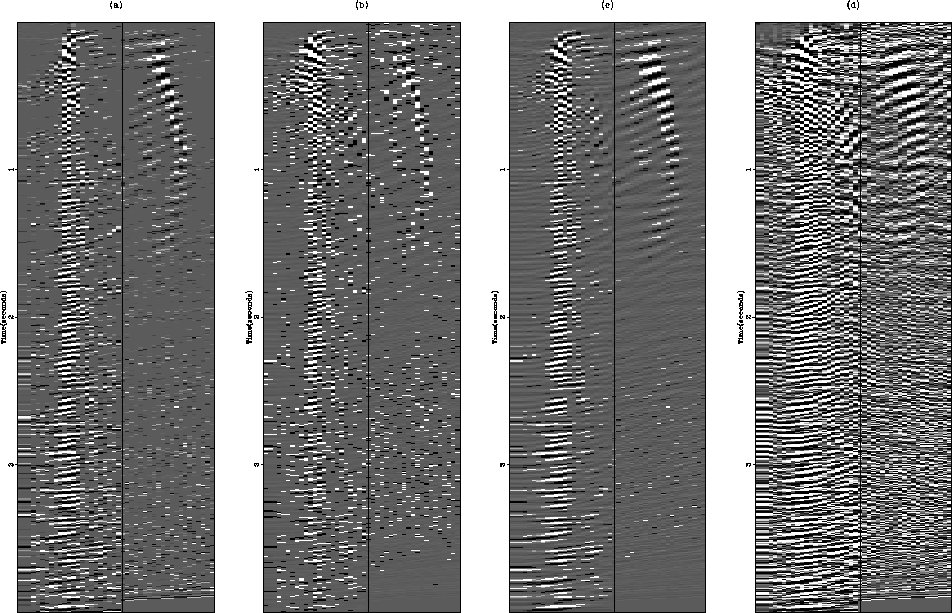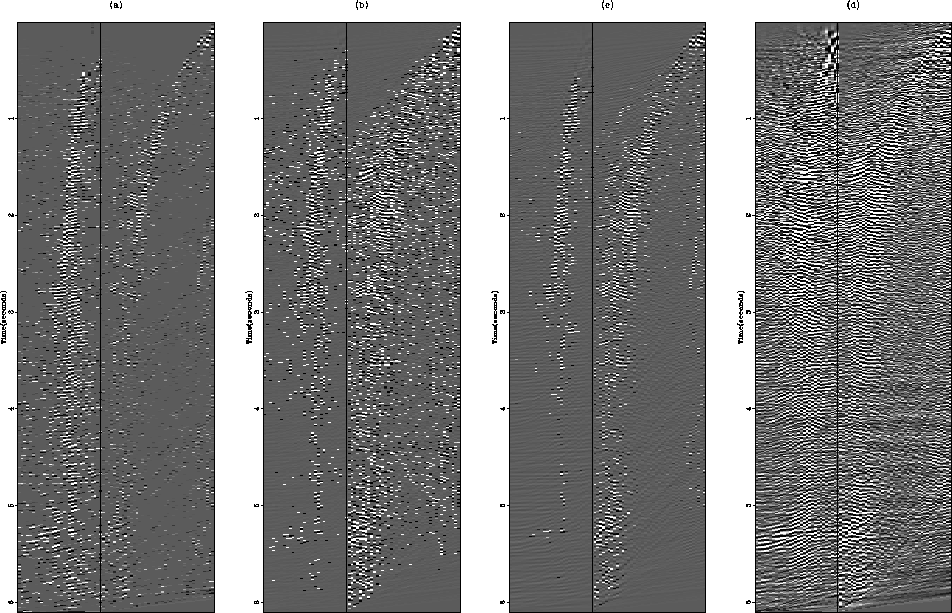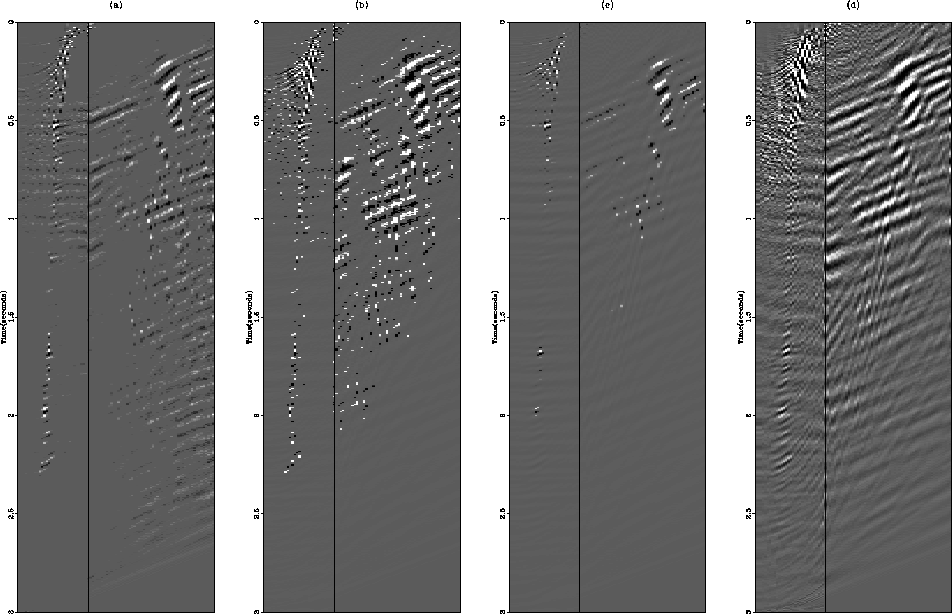




Next: Data residuals
Up: Noise separation in field
Previous: Noise separation in field
Figure ![[*]](http://sepwww.stanford.edu/latex2html/cross_ref_motif.gif) through
through ![[*]](http://sepwww.stanford.edu/latex2html/cross_ref_motif.gif) contain the inverted
model domains associated with the four techniques explored herein.
Clearly the sparsity of the results decrease toward the right. Direct
interpretation of the model domain would be easier and more
accurate with the BC, Cauchy, and l1 results. Distict trains of
energy in the hyperbolic and linear domains are visible. Without
the clip set so low, the l2 result is not as bad as these panels
make it seem. A distinct fairway of energy, marginally larger than
that presented in the l1 result is visible. Velocity analysis of
the gathers would likely be more accurate with the results that impose
sparsity, especially at late times.
contain the inverted
model domains associated with the four techniques explored herein.
Clearly the sparsity of the results decrease toward the right. Direct
interpretation of the model domain would be easier and more
accurate with the BC, Cauchy, and l1 results. Distict trains of
energy in the hyperbolic and linear domains are visible. Without
the clip set so low, the l2 result is not as bad as these panels
make it seem. A distinct fairway of energy, marginally larger than
that presented in the l1 result is visible. Velocity analysis of
the gathers would likely be more accurate with the results that impose
sparsity, especially at late times.
m.08
Figure 4 Model-space inversions of
shot-gather 08 (Panel (a) from Figure ![[*]](http://sepwww.stanford.edu/latex2html/cross_ref_motif.gif) ). The first half
of the panels is HRT space and the second half is LRT space.
Panel (a) shows the BC, Panel (b) the Cauchy, Panel (c)
the l1, and Panel (d) the l2 inverted model spaces.
). The first half
of the panels is HRT space and the second half is LRT space.
Panel (a) shows the BC, Panel (b) the Cauchy, Panel (c)
the l1, and Panel (d) the l2 inverted model spaces.




 m.14
m.14
Figure 5 Model-space inversions of
shot-gather 14 (Panel (b) from Figure ![[*]](http://sepwww.stanford.edu/latex2html/cross_ref_motif.gif) ). The first half
of the panels is HRT space and the second half is LRT space.
Panel (a) shows the BC, Panel (b) the Cauchy, Panel (c)
the l1, and Panel (d) the l2 inverted model spaces.
). The first half
of the panels is HRT space and the second half is LRT space.
Panel (a) shows the BC, Panel (b) the Cauchy, Panel (c)
the l1, and Panel (d) the l2 inverted model spaces.




 m.25r
m.25r
Figure 6 Model-space inversions of
shot-gather 25 (Panel (c) from Figure ![[*]](http://sepwww.stanford.edu/latex2html/cross_ref_motif.gif) ). The first half
of the panels is HRT space and the second half is LRT space.
Panel (a) shows the BC, Panel (b) the Cauchy, Panel (c)
the l1, and Panel (d) the l2 inverted model spaces.
). The first half
of the panels is HRT space and the second half is LRT space.
Panel (a) shows the BC, Panel (b) the Cauchy, Panel (c)
the l1, and Panel (d) the l2 inverted model spaces.





In general the l1 inversion produced consistantly better model
space realizations. While the differences are often minor, the method
provides consistant, stable, high quality results.





Next: Data residuals
Up: Noise separation in field
Previous: Noise separation in field
Stanford Exploration Project
5/3/2005
![[*]](http://sepwww.stanford.edu/latex2html/cross_ref_motif.gif) through
through ![[*]](http://sepwww.stanford.edu/latex2html/cross_ref_motif.gif) contain the inverted
model domains associated with the four techniques explored herein.
Clearly the sparsity of the results decrease toward the right. Direct
interpretation of the model domain would be easier and more
accurate with the BC, Cauchy, and l1 results. Distict trains of
energy in the hyperbolic and linear domains are visible. Without
the clip set so low, the l2 result is not as bad as these panels
make it seem. A distinct fairway of energy, marginally larger than
that presented in the l1 result is visible. Velocity analysis of
the gathers would likely be more accurate with the results that impose
sparsity, especially at late times.
contain the inverted
model domains associated with the four techniques explored herein.
Clearly the sparsity of the results decrease toward the right. Direct
interpretation of the model domain would be easier and more
accurate with the BC, Cauchy, and l1 results. Distict trains of
energy in the hyperbolic and linear domains are visible. Without
the clip set so low, the l2 result is not as bad as these panels
make it seem. A distinct fairway of energy, marginally larger than
that presented in the l1 result is visible. Velocity analysis of
the gathers would likely be more accurate with the results that impose
sparsity, especially at late times.


